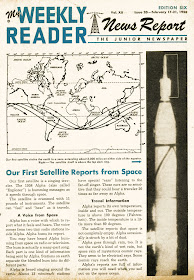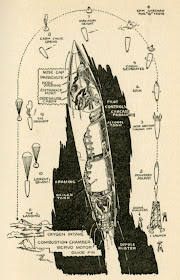Part 1 of this post is at:
http://dreamsofspace.blogspot.com/2012/02/japanese-space-encyclopedia-1971-part-1.html
We pick up this space encyclopedia after we have landed on the Moon. I love this exploration vehicle, although it looks more like some of the proposed Mars "RV" vehicles. It look like explorers could travel for several days in this beauty. although I lied in the previous post about showing the Moonbase, I guess I was just dreaming.
And onward to Mars! I think this "shot" comes just before the other cover painting. I like the beautiful south pole and rich spring greenery.
A very nice shot of Jupiter and a ship that would not look out of place in 2001. Well equipped for the long voyage outward from Earth.
The reason I guess this is an encyclopedia are the 4 pages of text at the end. Since I don't read Japanese I thought I could at least show the really cool border they put around the text.
Here is the diagram showing how the space station and the shuttle would work.
And this diagram lays out our plan for conquest of the solar system.
A lot of really neat paintings that remind me of the wonders of space exploration that still might be yet to come.
Monday, February 27, 2012
Friday, February 24, 2012
Uchu-u Ryoko (travel/trip in the universe). (1971?) Part 1
Thanks for putting up with my Weekly Reader posts, now back to cool space art. Not reading Japanese I can't tell you much about this thin "board" book. It seems to be part of a pictorial encyclopedia series. This volume is about our future in space! You are looking at the back cover. Since I ended scanning most of the illustrations I will break this post into 2 parts.
My readers rescue me again! Chris says:
"The title of the book is uchu-u ryoko (travel/trip in the universe). It's a picture book for the 3-5 years old kids (the numbers in the right). It's for the kids before the primary school (maybe "kindergarten" ?)."
My friends over at Project Sword Toys will appreciate this one. It reminders me of Thunderbirds vehicles. Someone was familiar with the Cape Kennedy "crawlers" but guessed how space shuttles might use them.
Here are some beautiful painting of dramatic re-entry procedures.
There is also a beautiful painting of the space station and how the space shuttle would be using it.
The book seems to follow the "space progression" so the next step is landing on the Moon.
I will be back next week with the moonbase, mission to Mars and some cool space graphics.
My readers rescue me again! Chris says:
"The title of the book is uchu-u ryoko (travel/trip in the universe). It's a picture book for the 3-5 years old kids (the numbers in the right). It's for the kids before the primary school (maybe "kindergarten" ?)."
My friends over at Project Sword Toys will appreciate this one. It reminders me of Thunderbirds vehicles. Someone was familiar with the Cape Kennedy "crawlers" but guessed how space shuttles might use them.
Here are some beautiful painting of dramatic re-entry procedures.
There is also a beautiful painting of the space station and how the space shuttle would be using it.
The book seems to follow the "space progression" so the next step is landing on the Moon.
I will be back next week with the moonbase, mission to Mars and some cool space graphics.
Thursday, February 23, 2012
My Weekly Reader April 1958
April 7, 1958
The science supplements in My Weekly Reader were interesting also. Not to read too much into them but the tone and information shared does suggest a certain point of view about what the U.S. "should" be doing in the space race.
Again there is a "timetable for space" presented for our future in space. We were to land on the Moon sometime between 1968 and 1978.
Here is the news from our second successful satellite launch
Note also the article "Five Spacemen Return". Even if we could not launch a man into space it didn't keep us from suggesting it was the next step.
April 21, 1958
There were different My Weekly Readers for different grades. Here is the rewritten space station and satellite articles aimed at a more advanced student.
Wednesday, February 22, 2012
My Weekly Reader March 1958
March 3 1958
"What makes a good spaceman?
I like the timetable for space. Even if we had not announced it was a race, children were now given a way to measure our progress against the news they heard. Note they do not predict a manned moon landing until 1978.
March 17 1958
For anyone who argues that the X-15 program was not part of space exploration, here it is in print stating they expected Capt Kincheloe to be the first American in space.Let's hear it for "space food". This has to be one of the earlier articles for the general public about food in space.
Friday, February 17, 2012
My Weekly Reader February 1958
February 3, 1958
My Weekly Reader was always a little behind the "real" news so the success of Vanguard took a little time to be brought to the attention of school children. When it did appear it was presented as the first step in our travel to the moon and beyond. February 17, 1958
Sorry for the incomplete page but I like both the "Message to young Americans" from Von Braun and the last line of the cherry pie champion of Canada!
"I can hardly wait for space travel to start. I'm pretty sure the red color of the planet Mars comes from the juice of cherry pies!"
A very incomplete page, but gives the sense of how children were being told this was the most important moment of history they were going to be living through.
Wednesday, February 15, 2012
My Weekly Reader January 1958
January 6, 1958
No mention of the recent failure just a reminder that we were moving forward January 20, 1958
"The moon is a long way from the earth" (so don't expect any results soon)
Monday, February 13, 2012
My Weekly Reader December 1957
December 2, 1957
As we continue on, the U.S. does have a response to Sputnik(s) planned, The Army's Jupiter C launcher.
Lots of space news now. The show of strenth is at hand and we will join the race in earnest.If this seems like a lot for 1 issue it is because during the same week they would have different Weekly Readers for different grade levels.
December 9, 1957
In the December 9th issue they had a supplement about the Moon. Obviously our next stop once we finished getting ahead of the Russians.Thursday, February 9, 2012
My Weekly Reader November 1957
November 4, 1957
This is a very small item in the November 4th issue. But the U.S.. needed to show they were in the race and so announcing that a rocket had been launched (maybe the first such announcement in My Weekly Reader) had a lot of value in showing "we" were in the race for space.
November 18, 1957
But of course as we know the Russians followed up the satellite launch with the launch of a living thing, a Siberian Husky Dog. It was hard to compete with that but My Weekly Reader reminded us that the Russians were cruel and humane societies all of the world were protesting the flight. The Russians may seem ahead but they were "cheating" unlike the humane Americans.
Wednesday, February 8, 2012
My Weekly Reader October 1957
1957 October 21
My Weekly Reader has always been a favorite with my readers. I recently got a year worth of them from the 1957-1958 school year. So as a quick post and a favor to all those nostalgia bufffs who keep "Googling" My Weekly Reader, I thought I would present a month by month scan of the space news I found in them. OCTOBER 28, 1957
Just for fun I scanned the reading questions from the back page. How did you do?
Friday, February 3, 2012
The Prentice-Hall Book About Space Travel / The True Book About Space Travel (1954/1955) PART 2
As promised I have some more space art to share from these books. For the first post see here:
http://dreamsofspace.blogspot.com/2012/01/prentice-hall-book-about-space-travel.html
The art in The True Book about Space Travel had been redone for American publication a year later.
The first one up is this nice diagram of a manned flight. This is based closely on the British Interplanetary Society's (BIS) plans for a manned ship.
http://dreamsofspace.blogspot.com/2012/01/prentice-hall-book-about-space-travel.html
The art in The True Book about Space Travel had been redone for American publication a year later.
The first one up is this nice diagram of a manned flight. This is based closely on the British Interplanetary Society's (BIS) plans for a manned ship.
The next is the surface of Mars
Finally the V-2 "bumper" rocket set up that were the only actual rocket tests going on at the time.
Any conclusions to be drawn from these drawings? Mostly they are interesting to see how two artists interpreted the same scenes.





















































